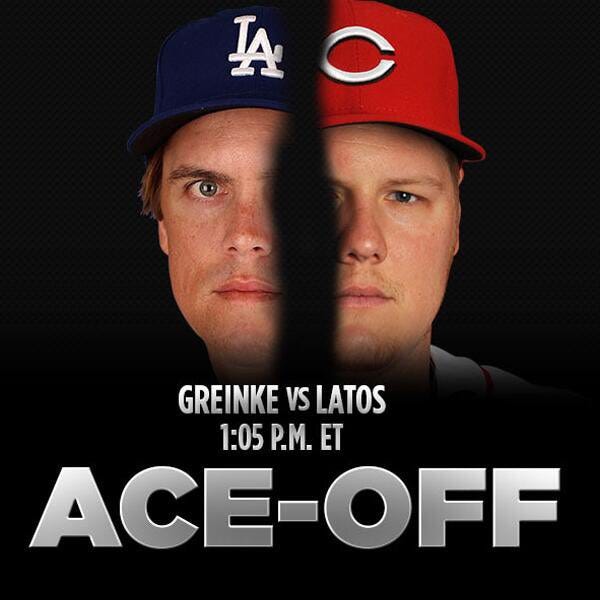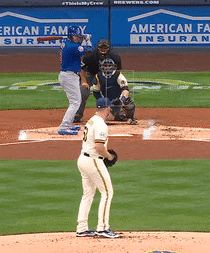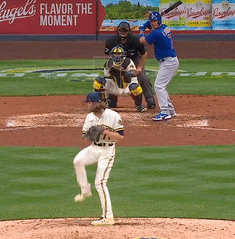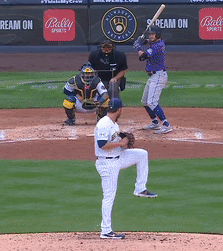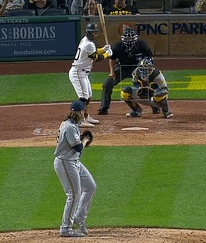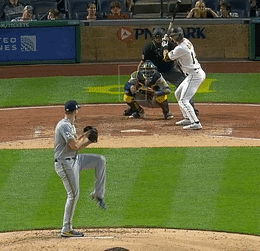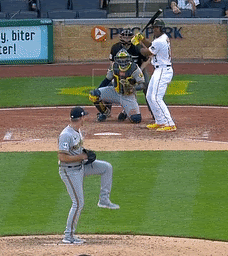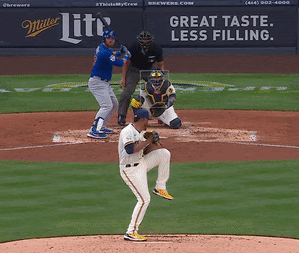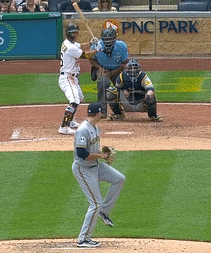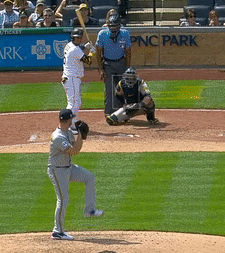Rowdy, Bailey and Josh.
The Brewers made yet another early trade, a look at a possible Twins rotation contributor and an underlying secret to the Brewers' success.
Happy Wednesday.
As I write this, Jacob deGrom and Corbin Burnes are about to face off in another classic MLB #AceOff.
Side note: for a good trip down memory lane, check out Mat Latos’ Reference page to a) remember how good he was for a good stretch of years b) see how many teams he played for down the stretch of his career that you have literally zero recollection of.
Let’s converse.
R-o-w-d-i-e, that’s the way we spell Rowdy
~Curt
What do you call it when the two primary player acquisition mantras of David Stearns collide into one?
No, actually. What do you call it? I legitimately don’t know and wish I did, because that is exactly what happened when the Brewers traded for Rowdy Tellez on Tuesday.
Stearns, the Brewers president of baseball operations, woke up and saw the scribbled post-it note on his mirror that read “Acquire a first baseman or die trying.” Then, as he brushed his teeth, the tattoo on the inside of his lip that says “You can turn a crate of poo-flinging monkeys into a capable bullpen” (the font is incredibly small) reminded him that the Brewers can, after all, probably turn a crate of poo-flinging monkeys into a capable bullpen.
Then, a few hours later, he acquired a first baseman, Tellez, in exchange for a bullpen arm--one that he got in return for a pair of promising bullpen arms just seven weeks prior, for that matter--in Trevor Richards.
The list of players the Brewers have tried at first base in the Stearns Era continues to grow. Chris Carter, Eric Thames, Jesus Aguilar, Ji-man Choi, Ryan Braun, Justin Smoak, Jedd Gyorko, Dan Vogelbach, Keston Hiura and now Tellez.
But that’s more of a fun aside than the actual point here: the Brewers exude confidence in their ability to develop pitching internally.
This has been one of the hallmarks of the Brewers, especially since 2018, when the run prevention unit led by noted stalwarts Jhoulys Chacin and Wade Miley pitched to a combined 3.22 ERA in 51 starts.
Since then, the Milwaukee Pitching Machine has flexed its muscle in different ways. Brandon Woodruff turned from promising young arm to top-10 pitcher in baseball. Corbin Burnes went from the worst starter in the game to All-Star who possesses one of the nastiest arsenals in baseball. Jordan Lyles turned in an incredible two-month stretch, then went to Texas on a nice little contract and reminded everyone that he wasn’t actually that good. They flipped consistent performers Chase Anderson and Zach Davies on team-controlled deals, confident they could replace their production.
Perhaps most relevant to the team’s current roster construction--and definitely most relevant in regards to their latest trades--the Brewers brass believes it can churn out solid big league relievers from a variety of avenues. And, in return, that means they can deal from current middle relief depth when they find unconventional value to be available via trade.
Devin Williams turned one filthy offering into a Rookie of the Year award. Eric Yardley squeezed out an absurd 2020 season from a sidearm, grounder-inducing profile. Justin Topa and Jake Cousins went from independent ball guys with interesting sliders to legitimate big league relievers. Hunter Strickland was there to be picked up for next to nothing. JP Feyereisen had secondary offerings to be unlocked when the Yankees put him on waivers.
It doesn’t always work (hello, Phil Bickford), but the Brewers have been able to build an above average bullpen without throwing significant assets via money or players in a trade in that direction. (And also by having Josh Hader. That tends to help.)
So, when the Blue Jays have one large Rowdy Tellez and not a lot of room for him on their roster, and the Brewers have an eternal need for more offense, it doesn’t become all that difficult for Milwaukee to trade Trevor Richards (along with fringe big-league arm Bowden Francis) away to get the Big Boi.


As for Tellez himself, there is no denying he struggled with Toronto before being sent to Triple-A this year. A .209/.272/.338 slash line ain’t gonna cut it, especially not if you play first base.
But, while I love overreacting to 50-game samples in an irrational sense, you also won’t find #RationalCyrt overreacting to 50-game samples. And that goes for samples both good and bad.
Sure, Tellez isn’t the 133 wRC+ hitter he was in last year’s shortened season. But he also hit at every level in the minors (including a 171 wRC+ in Triple-A since being demoted this year) and isn’t the guy with a .610 OPS we saw with the Blue Jays this year.
The league adjusted to Tellez in 2021 by throwing him more off-speed and he struggled in return. An adjustment by Tellez to the adjustment by the league can shift the balance right back in the bopper’s (and the Brewers’) hands.
Do the Twins have something here? The Bailey Ober edition
~Jake
We just passed the halfway point in the season and we Twins fans are well into the “Do they have something here” stage of the baseball grieving process. This is the point of the year where you start to see some guys whose name you don’t recognize or maybe you recognize it from a draft like eight years ago and had forgotten was in your system. You look at those names and see a couple good plate appearances or a nasty pitch and wonder aloud to your sweaty Grain Belt, “Could this guy be someone for us next year?”
Most of these guys end up being trivia facts, not rotation stabilizers. With your heart already broken by the everyday starters, though, it’s nice to think about this random 29-year-old you’ve never heard of and think he’ll be your next slugger. We also call this the Chris Colabello Stage of Grieving.
While we hold on tightly to the white flag for the Twins season, we’ll look at a few guys over the rest of this year, starting with right-handed pitcher Bailey Ober.
--------------
Ober, a starting pitcher throughout his entire minor league career, entered the year as the Twins’ No. 22 prospect according to FanGraphs despite putting up consistently strong earned run averages and strikeout rates. Much like Luis Arraez, Ober was an unheralded prospect who routinely performed well as a minor leaguer. His best season came in 2019, when he went 8-0 with a 0.69 ERA in 78-2/3 innings across three levels of the minor leagues (rookie ball, Single-A and Double-A). He struck out 100 batters and walked just nine in that time.
Then, of course, 2020 happened and he didn’t pitch at all, having been left off the 60-player pool.
He started the year with the St. Paul Saints but made just two starts there before he was called up to the big leagues to replace an injured Michael Pineda. His big league debut didn’t exactly go great, as he allowed five hits (two home runs) and four runs in four innings against the Chicago White Sox. That’s not ideal, but certainly not surprising for a team’s No. 22 prospect who has just six starts above Single-A under his belt.
Now, however, the 6-foot-9 starter has seven starts on his big league resume and some data we can work with. He has a 4.85 ERA and a 5.01 FIP, neither of which are great, but are actually above average as far as Twins starters go; he’s third in ERA and fourth in FIP among Twins starters. Even more notably, he leads all Twins starters with a 26.2 strikeout percentage, edging Jose Berrios’ 24.7% mark, while keeping walks in a reasonable range (2.73 walks per nine).
Ober does so by throwing a seemingly mediocre fastball that averages just 92.1 miles per hour. Before we go deeper, let’s just look at the basics again--he’s a 25-year-old righty who was drafted in the 12th round out of College of Charleston, entered 2021 as Minnesota’s No. 22 prospect, has just four starts above Single-A and throws 92 miles per hour...not exactly a future all star in the making.
And yet there’s something to Ober. His fastball clearly plays well despite the average velocity, perhaps because of his height and extended release point. He throws it 60.2% of the time and opponents have managed just a .324 slugging percentage against it, less than half the rate of any other pitch. His other pitches meanwhile range from fine (curveball) to not good (slider, changeup). FanGraphs graded his changeup as his best pitch with a 60 (on an 80-grade scale) but hitters have tagged it for a .889 slugging percentage so far. It’s certainly a small sample at just 73 pitches thrown, but that’s one thing to keep an eye on with Ober.
As you might imagine, Ober has to tow a fine line with a repertoire like that. When hitters swing at Ober’s pitches in the zone, they tend to get hit. Only five pitchers in the big leagues allow more contact on pitches in the zone and he tends to get hit hard (29% hard hit rate). His pitches must appear meaty, because batters are chasing tons of them. This is generally a good thing, because pitches out of the zone are harder to hit and harder to hit well. This combination, though, can lead to some stinkers of games like we’ve seen already.
When it goes well, though, it clearly goes well as we saw in Monday’s win against the White Sox. His first win of his career came in a day where he struck out seven in five innings and allowed just two hits and three walks, nibbling on the corners all day.
Ober is producing the way the Twins hoped J.A. Happ, Matt Shoemaker and Randy Dobnak would pitch. They don’t need him to be a front of the rotation guy like Berrios or replicate Kenta Maeda’s 2020 performance. Ober is the sort who can fill out the back end of a rotation, though, and, as Happ, Shoemaker and Dobnak have shown, that’s no small task.
Avoiding Josh Hader
~Curt
It has been well-documented, including around these parts, how the Brewers are utilizing Josh Hader in a different role than years past.
What we haven’t documented, though, is how good the Brewers have been at not having to utizlie Hader, as well.
Hader has only pitched in 33 games, or 39 percent of the team’s 86 games this year, almost exclusively throwing just one inning each time. He is on pace to throw 61 innings this year, down from 81.1 in 2018 and 75.2 in 2019.
While, yes, there have certainly been a small handful of spots where the Brewers didn’t utilize Hader but you could argue they could have without breaking away from the one-inning-per-game mold, it’s hard to debate the results.
Hader has been as good as we’ve ever seen, allowing only two runs all season. His K-BB% numbers aren’t quite as strong as they were when he won back-to-back NL reliever of the year awards, but hitters simply aren’t doing damage when they do make contact.
A rested Hader is an effective Hader. And the Brewers have excelled at pouring in runs late in close games, in turn flipping a Hader save situation into a Hoby Milner or Hunter Strickland mop-up outing.
Here’s a look at each game since late April that seemed destined for a Hader appearance until the Brewers offense extended the lead and the secondary relievers held it.
4/25/21- Brewers lead 1-0 in the top of the ninth, score five runs to beat the Cubs 6-0.
5/29/21- Brewers break a 2-2 tie with four runs in top of sixth in seven-inning game at Washington to win 6-2. Used Hader the next two days as he picked up a save and pitched a scoreless frame in a walk-off win.
6/4/21- Brewers lead 4-1 in the bottom of the eighth, get a run off a Narvaez homer to sit Hader down in 5-1 win.
6/8/21- Brewers lead 3-1 in the top of the ninth, score twice to sit Hader down and win 5-1.
6/10/21- Brewers score 3 between seventh and eighth to turn a 4-2 game into a 7-2 win. Hader saved the next 3 games
6/26/21- Brewers tie Rockies in the bottom of the seventh and then score six in the eighth for a 10-4 win
6/28-21- Brewers tied 4-4 in the bottom of the eighth….and score 10 (lol) runs.
7/1/21- Brewers lead 4-1 in the top of the ninth and score three runs to turn it into a 7-2 win.
7/2/21- Brewers lead 5-2 in the top of the ninth and score twice in a 7-2 win.
I’m not a mathematician, but that’s eight games where Hader was on the precipice of coming in to pitch but didn’t have to because the Brewers made the margin comfortable enough to where they didn’t need him.
This isn’t the thing that is going to put the Brewers over the top, but it can only help a good team take the next step late in the season.
Here, watch some filth
~Curt







